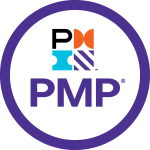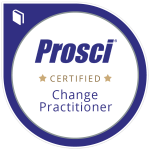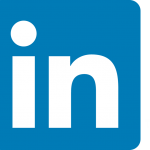
We are a product of our our history, our environment and our aspirations. Traditional management is straining under our current environment, and today, more than at any time in our professional careers, we have an opportunity to define our future- the future of management and the future of business improvement.
How ready are you and your organization?
First Observation: Traditional Management Tools Have Become a Commodity
All of us involved in management have and use our own management toolkit. We keep it close to us like a old friend.
We have selected these tools from our own education, books by management experts, published articles, posted content, other managers and employees, and consultants. We have honed and fine-tuned our tools through our own experience, and, like a professional golfer, we pull them from our bag at just the right time- to produce the desired outcome.
We reach for these familiar tools and proven techniques when we are feeling the sting of the competitive environment or the blunt trauma of the business cycle. Often we respond to the pressure of our fiduciary roles with the fluency of, for example, benchmark scores… a tool that has been a “top 10” favorite in the Bain & Company Management Tools survey for more than 17 years.
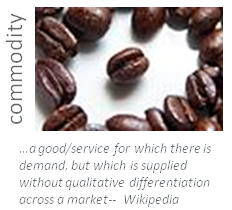 As a matter of fact 80% of the Bain & Company 2001 Management Tools “top 10” are still in the “top 10” for 2011 Management Tools, according to various Bain studies and reports (See our management tool overview). These minor changes in popular use confirm our observation as a practitioner and advisor- management tools have become a commodity. And we are not the only ones noticing this phenomenon.
As a matter of fact 80% of the Bain & Company 2001 Management Tools “top 10” are still in the “top 10” for 2011 Management Tools, according to various Bain studies and reports (See our management tool overview). These minor changes in popular use confirm our observation as a practitioner and advisor- management tools have become a commodity. And we are not the only ones noticing this phenomenon.
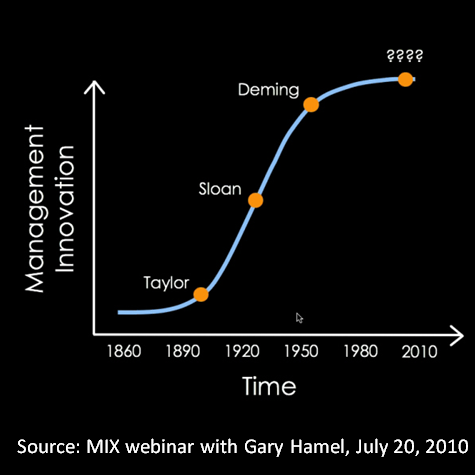 In a recent video post, Gary Hamel, a leading influential business thinker according to the Wall Street Journal, talks about industrial-age management tools being at an inflection point. The tools created out of the necessity to train and manage an agrarian work force to be cogs in a centrally managed enterprise organized by span of control has plateaued at the top of the s-curve. Still others, have picked up on this concept as well.
In a recent video post, Gary Hamel, a leading influential business thinker according to the Wall Street Journal, talks about industrial-age management tools being at an inflection point. The tools created out of the necessity to train and manage an agrarian work force to be cogs in a centrally managed enterprise organized by span of control has plateaued at the top of the s-curve. Still others, have picked up on this concept as well.
Historian Elin Whitney-Smith has studied long-waves of disruption, and provides a point-of-view focused on information revolutions. In a Booz & Co. published interview she articulates the revolution does not come from the stable status-quo, but rather from the edges- from people who are just gaining access to information for the first time. Whitney-Smith believes organizations surviving the current digital information revolution will “involve more people at lower levels in decision making”.
Be it the “s-curve” of business management, the long-wave of information revolution and/or the lack-luster pace of recovery from the great recession, successful organizations need innovation, not best practices, to “leap” to the next s-curve of growth and improvement.
Is your primary focus innovation or best practices?
Second Observation: For our knowledge-worker workforce, emerging social tools eliminate barriers to collaboration and facilitate innovation
Knowledge workers have high degrees of expertise, education or experience, and the primary purpose of their jobs involves the creation, distribution, or application of knowledge
Tom Davenport, Thinking for a Living
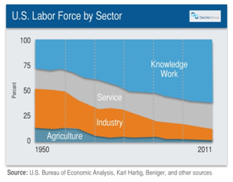
Knowledge workers represent up to 75% of the workers in some industries, such as health care and education, and make up more than half of the total workforce. (See inset US Labor Force by Sector)
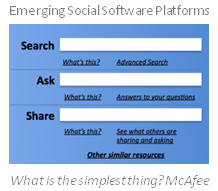
Emerging social technologies support the knowledge worker. Social software platforms can help eliminate collaboration’s historic barriers of time, location and privileged access to information. According to Andrew McAfee, Principal Research Scientist at MIT’s Center for Digital Business, in its simplest form, social software platforms focus on search, ask and share activities.
Creating a knowledge worker supportive environment can facilitate collaboration and help unlock what Robert Schaffer, The Breakthrough Strategy, calls the “hidden reserve” of workers available for focus within the enterprise or, most recently, what Clay Shirky, Cognitive Surplus, has popularized as the “cognitive surplus” of individuals outside the enterprise available for more civic-oriented work.
What are the collaborative (social) requirements for your organization?
Implication: Early Adopters- Innovators- Will Define the Next Generation Improvement Process
We must redefine how we work, how we lead and how we manage.
We must innovate workplace interactions and relationships- for individuals, for groups and for the organization (iGO).
We must provide a social environment, an enabled network- able to search, ask and share.
The path will not be a collection of industry best practices, but a tailored approach for each and every enterprise, integrating some of the traditionally proven management tools with emerging collaborative (social) platforms and applications focused on a more effective execution of strategy. The “art” of success will be defined by adoption- balancing defined business outcomes with the strategic intent of iGO innovation, and creating a unique and highly flexible enterprise.
We see a very exciting future:
- Organizations with a well defined network reducing the importance of the traditional organization structure
- “Environments”, including guidance, routines and interactions, allowing, for example, decision making to be pushed lower into the organization
- Collaboration supporting innovation, for example, of individuals through access to experts, communities and captured tacit knowledge
What are you doing to create iGO collaboration in your organization?
Have you integrated your operations to leverage these emerging technologies as part of your competitive differentiation? … as part of your strategy?
We have begun this journey with a number of clients and discovered a short list of themes for success, including:
- Start. Start now
- Involve and engage leadership early- even small steps demonstrate commitment
- Tools are important, but don’t wait. Contained social platforms, instances quickly setup behind the firewall, can provide rich new traditions and feed viral, organic adoption
- Focus on achieving business outcomes, in new ways- not by creating “additional” work
- Create a collaborative environment, including, as an example, a clear decision processes
- This must be led- so start with your sphere of influence
You are not alone. Here is a sampling of a number of companies publicly blazing the trail…
- HTC- Employees First, Customers Second
- Best Buy- Blue Shirt Nation
- Cisco- Creating a collaborative enterprise
- IBM- Social software at work inside IBM
- NASA- NASAsphere
- Booz Allen Hamilton- Hello
- US Intelligence Community
What is your point of view for innovating for the future of management in your organization?


